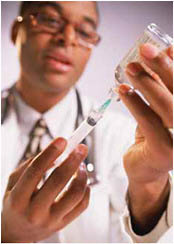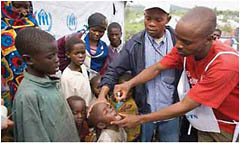
IV
Prevention and Treatment
Infectious disease may be an unavoidable fact of life, but there are many strategies available to help us protect ourselves from infection and to treat a disease once it has developed.
Some are simple steps that individuals can take; others are national or global methods of detection, prevention, and treatment. All are critical to keeping communities, nations, and global populations healthy and secure.
Vaccines and Medicines
Medicines have existed in human society probably as long as sickness itself. However, with the advent of the modern pharmaceutical industry, biochemical approaches to preventing and treating disease have acquired a new level of prominence in the evolving relationship between microbes and their human hosts.
Vaccines
A vaccine is a biological preparation that improves immunity to a particular disease. A vaccine typically contains an agent that resembles a disease-causing microorganism and is often made from weakened or killed forms of the microbe or its toxins. The agent stimulates the body’s immune system to recognize it as foreign, destroy it, and ”remember” it, so that the immune system can more easily identify and destroy any of these microorganisms that it encounters later. The body’s immune system responds to vaccines as if they contain an actual pathogen, even though the vaccine itself is not capable of causing disease. Because vaccines are widely used in the United States, many once-common diseases—polio, measles, diphtheria, whooping cough, mumps, tetanus, and certain forms of meningitis—are now rare or well controlled.
Vaccinated people produce antibodies that neutralize a disease-causing virus or bacterium. They are much
less likely to become infected and transmit those germs to others. Even people who have not been vaccinated may be protected by the immunity of the “herd,” because the vaccinated people around them are not getting sick or transmitting the infection. The higher the proportion of vaccinated people in a community, the lower the likelihood that a susceptible person will come into contact with an infectious individual—leading to greater herd immunity.
In the past, thimerosal, a preservative that contains mercury, was used in some vaccines and other products. Use of this product became the subject of controversy, with some arguing that the substance caused autism in children. Extensive, independent research has presented no convincing evidence of harm associated with the low levels of thimerosal present in vaccines. Since 2001, thimerosal has not been routinely used as a preservative in recommended childhood vaccines.
Antibiotics and Antivirals
Antibiotics are powerful medicines that fight bacterial infections. They either kill bacteria or stop them from reproducing, allowing the body’s natural defenses to eliminate the pathogens. Used properly, antibiotics can save lives. But growing antibiotic resistance is curbing the effectiveness of these drugs. Taking an antibiotic as directed, even after symptoms disappear, is key to curing an infection and preventing the development of resistant bacteria.
Antibiotics don’t work against viral infections such as colds or the flu. In those cases, antiviral drugs, which fight infection either by inhibiting a virus’s ability to reproduce or by strengthening the body’s immune response to the infection, are used. There are several different classes of drugs in the antiviral family, and each is used for specific kinds of viral infections. (Unlike antibacterial drugs, which may cover a wide spectrum of pathogens, antiviral medications are used to treat a narrower range of organisms.) Antiviral drugs are now available to treat a number of viruses, including influenza, HIV, herpes, and hepatitis B. Like bacteria, viruses mutate over time and develop resistance to antiviral drugs.
New Treatments
Modern medicine needs new kinds of antibiotics and antivirals to treat drug-resistant infections. But the pipeline of new drugs is drying up. For example, nearly 40 years elapsed between introduction of the two newest molecular classes of antibiotics: fluoroquinolones (such as Cipro) in 1962 and the oxazolidinones (such as Zyvox) in 2000.
Major pharmaceutical companies have limited interest in dedicating resources to the antibiotics market because these short-course drugs are not as profitable

as drugs that treat chronic conditions and lifestyle-related ailments, such as high blood pressure or high cholesterol. Antibiotic research and development is also expensive, risky, and time consuming. Return on that investment can be unpredictable, considering that resistance to antibiotics develops over time, eventually making them less effective.
New antiviral drugs are also in short supply. These medicines have been much more difficult to develop than antibacterial drugs because antivirals can damage host cells where the viruses reside. Today, there are more antiviral drugs for HIV than for any other viral disease, transforming an infection that was once considered a death sentence into a manageable chronic condition. But novel drugs are needed to combat other epidemic viral infections, such as influenza and hepatitis B and C.
Several programs have been developed to stimulate research and development of new vaccines and medicines. The U.S. Department of Health and Human Services recently formed the Biomedical Advanced Research and Development Authority, which provides an integrated, systematic approach to the development and purchase of the vaccines, drugs, therapies, and diagnostic tools necessary for public health medical emergencies. The Cures Acceleration Network provision of the Patient Protection and Affordable Care Act, signed into law by President Obama in March 2010, is designed to move research discoveries through to safe and effective therapies by awarding grants through the National Institutes of Health to biotech companies, universities, and patient advocacy groups. And nonprofit organizations dedicated to accelerating the discovery and clinical development of new therapies to treat infectious diseases are bringing together philanthropists, medical research foundations, industry leaders, and other key stakeholders to forge effective collaborations.
Microbe Awareness
Daily habits provide some of the strongest defenses against infectious diseases. Among the sensible actions you can take:
-
Keep immunizations up to date.
-
Wash your hands often. Washing with regular soap and rinsing with running water, followed by thorough drying, is considered the most important way to prevent disease transmission. Routine consumer use of residue-producing antibacterial products, such as those containing the chemical triclosan, have not been proven to confer health benefits and may actually contribute to antibiotic resistance.

-
Prepare and handle food carefully. (See “How to Protect Yourself” in the Foodborne Pathogens section on page 16.)
-
Use antibiotics only for infections caused by bacteria. Viral infections cannot be treated with antibiotics. Your doctor may prescribe an antiviral medication if your condition warrants it.
-
Report to your doctor any rapidly worsening infection or any infection that does not get better after taking a course of antibiotics, if prescribed.
-
Be careful around all wild animals and unfamiliar domestic animals. After any animal bite, cleanse the wound with soap and water and consult a clinician for further evaluation. Enjoy wild animals with your eyes, not by touching them.
-
Avoid insect bites whenever possible by using insect repellent and wearing long-sleeved shirts, long pants, and a hat outdoors.
-
Protect yourself by using safe sex practices. You and your partner should be tested for sexually transmitted diseases, including HIV, if there has been any risk of exposure. Consistently and correctly use condoms when having sex with a partner of unknown status. Avoid sex with an injecting drug user.
-
Stay alert to disease threats when traveling or visiting underdeveloped countries. Seek advice from a reliable source, such as the WHO or the CDC, if you are going to areas of moderate-to-high disease risk.
-
Acquire healthy habits such as eating well, getting enough sleep, exercising, and avoiding tobacco and illegal drug use.
Government Policies
Keeping our nation safe from disease outbreaks depends on effective and well-coordinated programs that monitor public health. What are some of the key efforts at work in the United States?
Public Health Capacity
The mission of public health is to safeguard and improve the health of the community as a whole. Effectively responding to infectious disease threats therefore requires a robust public health system. In the United States, public health surveillance for infectious diseases is conducted through a variety of agencies. Health care providers and others report cases of notifiable infectious diseases (as defined by local and state health codes) to state health departments. State health department officials, in turn, verify disease reports, monitor disease incidence, identify possible outbreaks, and forward their findings to the CDC. The CDC and other federal agencies, including the Food and Drug Administration, the U.S. Department of Agriculture, and the U.S. Department of Defense, independently gather and analyze information for disease surveillance.

CDC headquarters in Atlanta, Georgia.
Public health advocates have called for improved surveillance to better monitor infectious diseases across the country. Among their recommendations: a national electronic infectious diseases reporting system; innovative methods of disease surveillance (such as automated laboratory reporting of infectious disease or systematic gathering of informal reports of disease from the Internet); and fortifying the entire public health system, which historically has been underfunded compared to biomedical research.
Syndromic surveillance—the near- or real-time monitoring of nonspecific pre-diagnostic signs of disease outbreaks—is an innovative surveillance method that is being explored by some cities and states with assistance from the federal government as a means of providing early warning of infectious disease outbreaks. Syndromic surveillance rests on the idea that, following large-scale exposure to infectious disease in an epidemic or bioterrorist attack, people will first develop symptoms, stay away from work or school, and attempt to treat themselves before seeing a doctor. These systems therefore monitor school and work absenteeism, sales of over-the-counter medications, illness-related 9-1-1 calls, and other patterns that suggest an outbreak. However, most surveillance still focuses on tracking reported infections.
Food Safety
Foodborne diseases are largely preventable—but the goal requires vigilance in every step from the farm to the table. Good agricultural and manufacturing practices can reduce the spread of microbes among animals and prevent contamination of foods. Monitoring the entire food production process can pinpoint hazards and control points where contamination can be prevented, limited, or eliminated. A formal method for evaluating risk control is called the Hazard Analysis Critical Control Point, or HACCP (pronounced “has-sip”) system. First developed by NASA to ensure that the food eaten by astronauts was safe, HACCP safety principles are now being applied to a widening range of foods, including meat, poultry, seafood, fruit juices, and other products.

In recent years the U.S. Government Accountability Office, food safety advocates, and legislators have documented problems resulting from the fragmented nature of the nation’s food safety system. At least a dozen federal agencies, implementing at least 30 different laws, have roles in overseeing the safety of the nation’s food supply. Advocates have
recommended that all food safety activities be consolidated into a single federal agency with a unified mission.
International Cooperation
National borders offer trivial impediment to infectious disease threats. In the highly interconnected and readily traversed global village of our time, one nation’s problem soon becomes every nation’s problem. Therefore, many of the strategies described above must be implemented worldwide, not just nationally, in order to have a true impact.
Global Surveillance
Just as national surveillance is critical to controlling outbreaks within a nation, global surveillance is a critical component to responding to infectious disease worldwide. Among the strongest measures promoting worldwide infectious disease surveillance are the WHO’s revised International Health Regulations, which entered into force in 2007. These require WHO member states to report certain diseases and outbreaks that may represent public health emergencies of international concern to the WHO and to strengthen their capacities for public health surveillance, diagnosis, and response. In addition, the CDC’s Division of Global Migration and Quarantine, an integrated and comprehensive partnership of local, national, and global health authorities, works to prevent, detect, and contain infectious diseases in countries of origin and at U.S. ports of entry.

Technological advances in disease surveillance and detection such as regional syndromic surveillance, bioinformatics, and rapid diagnostic methods, have strengthened infectious disease control and prevention efforts. The global response to SARS, for example, was triggered by a report posted to the Program for Monitoring Emerging Diseases—or ProMED Mail—a global electronic reporting system for outbreaks of emerging infectious diseases and toxins.
Other networks are beginning to listen in on what scientists call “viral chatter”—the seemingly commonplace transmission of animal viruses to humans in parts of the world where the two populations overlap, such as live-animal markets or urban areas carved out of tropical rainforests. By identifying viruses, bacteria, and parasites in animals where they naturally live, and monitoring
those organisms as they move from animals into people, it may be possible to prevent deadly new infections of animal origin from entering and racing through human populations. The One Health Initiative, a worldwide movement to forge collaborations among physicians, veterinarians, and other related disciplines, is an example of efforts to improve communication about human and animal diseases.
Public Health in Developing Nations
The gaps in life expectancy between the richest and poorest countries now exceed 40 years—in large measure owing to the toll of infectious diseases. Safe water supplies, sewage treatment and disposal, improved food safety, and vaccination programs are urgently needed in developing nations. A major barrier to achieving these improvements is the underlying weakness of public health systems in resource-poor countries, including a shortage of health care workers, which hinders efforts to immunize, treat, and monitor the status of patients. Poor nations also lack disease surveillance programs and up-to-date laboratories, which are essential in the mission to find, diagnose, and contain infectious diseases.
Distribution of Medicines
Life-saving vaccines and medications are not distributed equitably around the world. More than half of those suffering from HIV/AIDS who need drug treatment are not receiving it. Only 2 percent of people with multidrug-resistant TB receive the right medications. And while children in wealthy countries are routinely immunized with vaccines that protect against childhood pneumonia and diarrhea, children in poor countries are not; for each child who dies from pneumonia in an industrialized country, more than 2,000 children die from the infection in developing countries.
Many factors influence whether poor nations can obtain affordable drugs of good quality. Most drug research and development is not geared toward the needs of people in poor countries because they are not a large market. As a result, a large percentage of the money spent worldwide on health care research is dedicated to problems affecting a small percentage of the world’s population. Social and political challenges to the distribution of medicines are factors as well. Efforts are being made by foundations, pharmaceutical companies, and other organizations to overcome these challenges, providing funding, research, and donations of medications. The tragedy of global infectious disease is not only that so many lives are lost or damaged, it’s that so many of these infections could be prevented or treated effectively with low-cost drugs.

Two health workers give a child polio vaccine during a vaccination campaign in the Democratic Republic of the Congo.







